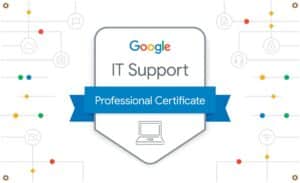In today’s rapidly evolving digital landscape, IT professionals equipped with transferable skills are in high demand across industries. With technology seeping into almost every aspect of business, there is a tenfold increase in IT Support jobs all over the world, where companies are waiting for skilled and motivated people who can fill them.
Many people who have the potential to do these jobs are looking for a flexible way to learn the necessary skills. They might not have a university degree or access to in-person training, or maybe the cost is too high.
Recognizing the increasing need for these transformative capabilities, Google has collaborated with Coursera to introduce a good opportunity for aspiring IT professionals. The Google IT Support Professional Certificate is an in-depth online course designed to propel your journey from a novice to a proficient entry-level IT specialist over six months. This program is designed to solve the problems of access while providing hands-on learning and giving the foundational skills and confidence required for an IT Support job.
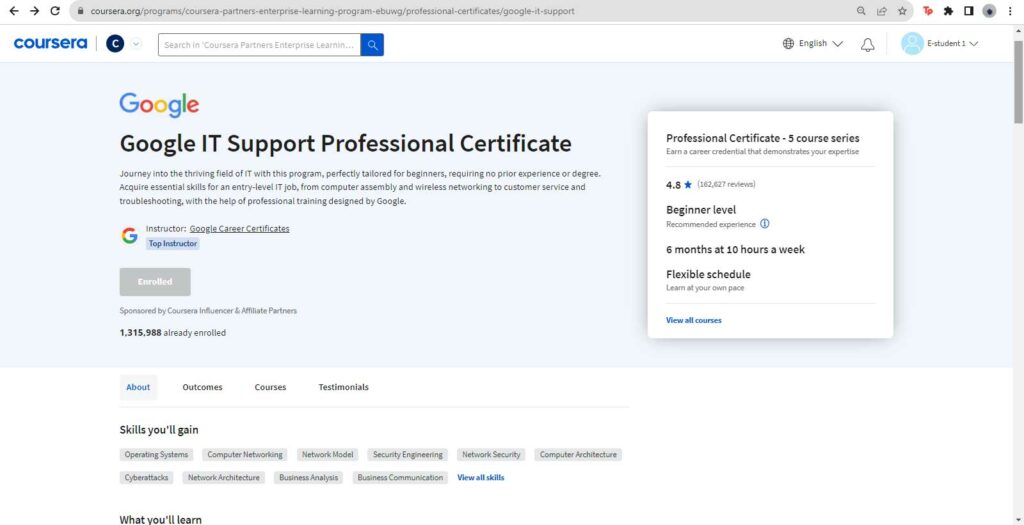
Table of Contents
Overview of the Google IT Support Professional Certificate
The program equips you with the skills required to excel in a starting-level IT job. It teaches you to perform day-to-day IT support tasks, including computer assembly, wireless networking, installing programs, and customer service. It also touches upon providing end-to-end customer support, ranging from identifying problems to troubleshooting and debugging. Finally, it explains how to use systems, including Linux, Domain Name Systems, and the Command-Line Interface. By the end of the course, you will have gained strong skills in Network protocols, cloud computing, the Windows operating system, the Linux command line, systems administration, encryption algorithms and techniques, and more.
The course lasts about six months if you commit about 8-10 hours a week, but you are free to go at your own pace, skip the sections you might already be familiar with, and spend more time on the fresher, more complicated concepts. While a major time commitment, the length of the course will signal that you have the dedication, persistence, and grit it takes to succeed in an IT job. Each course has 6-7 weeks of content, including videos, readings, quizzes, and Qwiklab assignments. You can review it all in one spot, go over it, and also skip to the section you wish to check first. For instance, I breezed through the first course on Technical Support Fundamentals in two days because I already knew a lot of it, but I moved more slowly through the remaining four courses.

Please note that I had access to the entire paid program, which provides complete access to all exercises and assignments. The pacing felt manageable and appropriate to me. However, keep in mind that you can audit any course that is a part of the Professional Certificate if you’re on a tight budget or would like to try out the Program before purchasing (albeit you won’t get access to all assignments or a certificate of accomplishment).
Alternatives and complements to this Certificate
While I recommend this program for most of those interested in getting started with IT support, exploring other options that might be a better fit for your situation is always a good idea.
The most obvious alternative is the IBM IT Support Professional Certificate on Coursera. While this is also meant to be a comprehensive course, it is shorter (at an estimated 3 instead of 6 months) and does not go into as much depth for the topics covered. It is, however, an excellent option if you are looking to get your certificate faster and move on to other learning (or job) opportunities.
A decent alternative to delving deeper into IT support, if looking for a cheaper course, is ‘Information Technology (IT) Support PC’ by IBM, available from edX. You can also acquire the CompTIA A+ Certification, which is the industry standard for establishing a career in IT. Note that the Google IT Support course also prepares you for the CompTIA A+ examination, so if you pass both, you will earn a dual certificate. The ‘IT Support Technical Skills Helpdesk‘ course on Udemy is also a decent and more affordable option to grab essential technical IT skills for an entry-level job in IT support. If you are looking to specialize in cybersecurity rather than general IT support, the Google Cybersecurity Professional Certificate on Coursera would be your best bet for getting started.
Level and prerequisites
The Certificate is meant to help teach enthusiasts to start their career in the IT industry with an entry-level IT support job, so it requires no prior experience or degree. However, many concepts in the course get challenging to digest if you are entirely a novice, so taking this course might be easier if you have studied computer science in high school. Nonetheless, if you are truly a tech enthusiast and have strong dedication, you are as likely to ace this program with no formal education in IT or computer science.
The majority of the ideas covered in the program’s later courses expand upon the fundamental technical support ideas covered in the first course, “Technical Support Fundamentals.” Those with no experience with IT or computer science can devote more time to the first course and practice enough to lay the groundwork for understanding the later courses in the certificate.
How much does the Professional Certificate cost?
The Google IT Support Professional Certificate is included in the Coursera Plus subscription, which costs $59 per month, and gives you access to the majority of Coursera courses (but not, for example, the IBM Data Engineering professional certificate). With the recommended 6-month completion time, this adds up to $354.
Since the program is self-paced, you might try to finish it sooner than the suggested number of months if you’re on a tight budget and want to save money. It is also possible to audit the individual courses of the Certificate for free, and the same is true for most Professional Certificates on Coursera.
You might also want to think about an annual Coursera Plus subscription, which costs $399, if you wish to study many programs on Coursera or if you expect to take longer to finish the program.
Is the Google IT Support Professional Certificate worth the money?
The program provides a great opportunity to prepare for an entry-level IT job and become proficient in highly in-demand skills ranging from computer assembly and wireless networking to customer service and troubleshooting, improving your job prospects in the IT industry. There are over 520,000 IT support positions in the US as of 2022, with a median starting salary of $57,000. It is expected that in the next decade, IT jobs will increase by 12% in the US alone. While some courses may require more work if you lack background knowledge in certain areas, the skillset you have at the end of the Certificate is highly valuable and in demand.
According to Coursera, 75% of Google IT Support Professional Certificate graduates report a successful career outcome within 6 months of completion, such as a new job, improved skills, a raise, or a promotion. This Certificate also prepares you for the CompTIA A+ examinations, the de facto standard for IT certification. Upon successful completion of both, you’ll receive a dual certificate. This Program is also ACE®-approved, so upon completion, you can receive up to 15 college credits, which is the equivalent of five bachelor’s degree-level college courses.
The Certificate offers adequate value for money, given the comprehensive nature of the content, supplemental exercises to practice them, and graded assessments to test your knowledge in real-world problems. This is especially the case if you are completing the program on an accelerated schedule and paying less.
Another feature of the program, which I found very valuable, was the professional tips on building a strong profile and preparing yourself for a promising interview for an IT support job. The courses include interview role plays that demonstrate the kinds of questions to expect and how to prepare for them and present yourself. It also includes readings and guidelines on how to make a professional resume, write a convincing cover letter, and create an impressive elevator pitch.
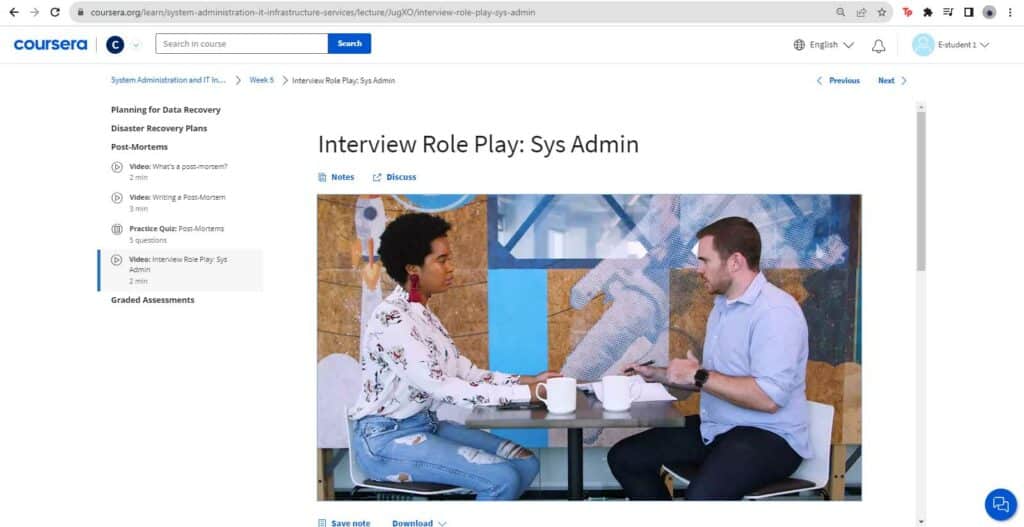
Syllabus overview
The complete Certificate program has five courses:
- Technical Support Fundamentals
- The Bits and Bytes of Computer Networking
- Operating Systems and You: Becoming a Power User
- System Administration and IT Infrastructure Services
- IT Security: Defense against the digital dark arts
Each course is broken down into 6–7 weeks, each with its own videos, readings, and quizzes, but you can reschedule the deadlines and move at your own pace to complete the courses. I have given a detailed overview of each course in the Review section of this article.
Who are the instructors?
The Professional Certificate is solely created and developed by Google. All of the course teachers are seasoned IT professionals who work for Google as experienced IT support staff. They are employed in IT disciplines such as operations, systems administration, security, and site reliability engineering. The five courses are instructed by Kevin Limehouse, a support specialist; Victor Escobedo, a corporate operations engineer; Cindy Coatch, a site reliability engineer; Devan, a corporate operations engineer; Phelan Vendeville, a site reliability engineer; Gian Spicuzza, a program manager at Android; Marti Clark, a manager at Google IT Support program; and Rob Clifton, a program manager.
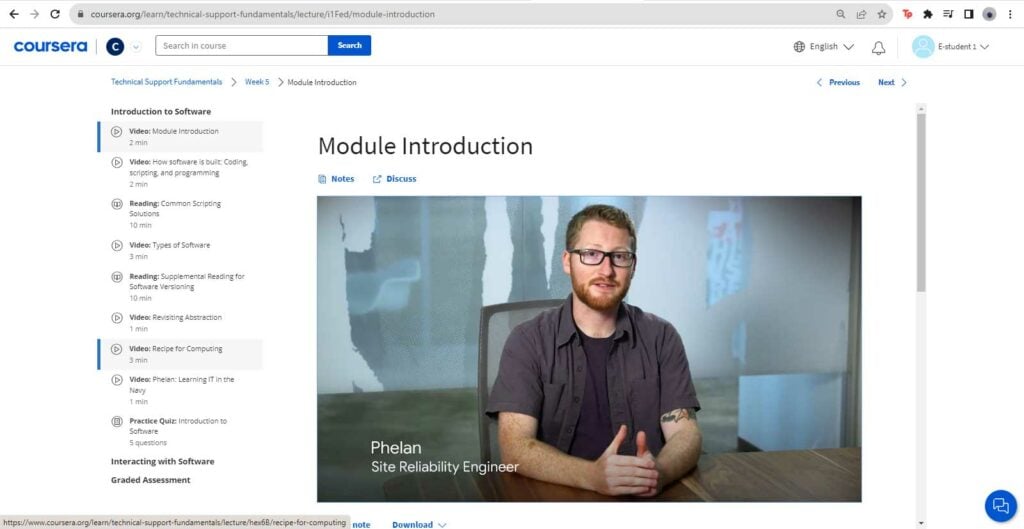
The course also introduces us to Googlers with unique backgrounds and viewpoints who share their experiences in the IT industry. They discuss how the basis of their IT support backgrounds functioned as a launching pad for their careers. They also provide insight into the daily tasks and advice on handling IT support interviews. They even discuss their own struggles and achievements in motivating ways.
I think this is a very effective way to encourage and motivate young learners to pursue their passion, giving them the reassurance they need. These videos made me feel quite hopeful and optimistic about completing the Certificate and strengthening my credentials before starting grad school. Listening to the stories of others who have been through the same doubts and walked the same path before becoming successful in their IT jobs ignites a renewed spark of confidence and motivation in those taking this course at the start of their IT careers.

Detailed review of the courses
Course structure
Each of the certificate program’s five courses lasts six to seven weeks. Each week concludes with a graded assignment. The framework of each course is the same, with an introduction to the course, overview, videos, readings, practice quizzes, and graded assignments at the end.
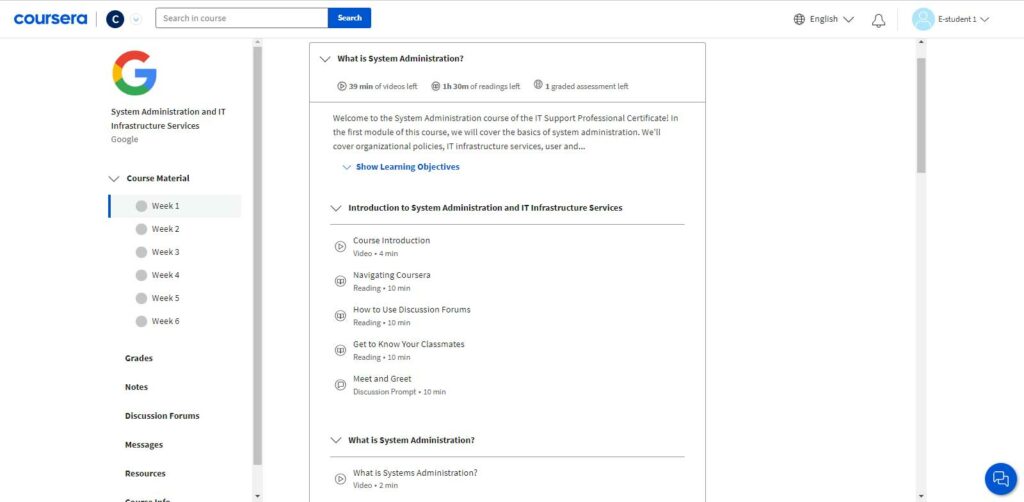
The majority of each course’s content is taught through videos, but each video is brief and only covers a certain area of the course. This way, you can avoid getting lost in longer videos and easily refer to a particular video if you need to revisit any content or return to a specific concept.
In addition to the videos, there are also brief readings that highlight key ideas, serve as written references, provide additional context, and have clear diagrams to illustrate the concepts.
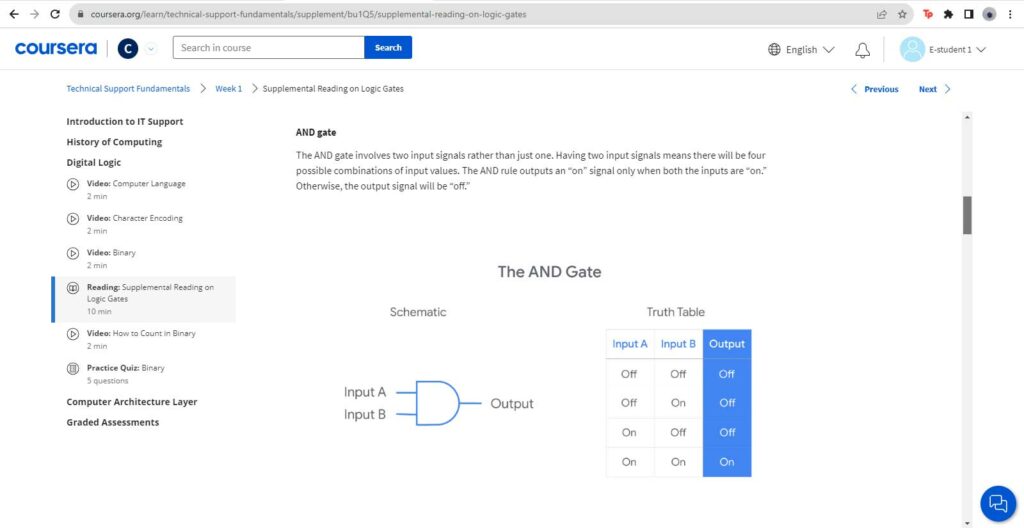
The readings also include helpful links to outside resources and technical websites where you can learn more about the topic at hand. These proved to be especially helpful for me in later courses where I was struggling with every new concept because I lacked prior knowledge. These external links make those ideas more understandable to you by explaining them in more depth.

There is a practice quiz that takes 5 to 30 minutes to complete after each topic in a course. These have MCQs, quick questions, and interactive exercises to complete. Although the practice quizzes are not graded, make sure you understand the previous topic before moving on to the graded assessment at the end of the week. They act as crucial exercises to test the material you’ve just learned and serve as a reminder to refer back to the readings and videos if you run into trouble answering a question. You can attempt these as many times as necessary until you get them correct because they are not graded, but I would advise that you only attempt them until you are certain that you understand all the previous concepts.

The Graded Assessments are either short questions or MCQs like the practice quizzes or are graded assessments that open in a new window. Some graded assessments are done on Qwiklabs, an online learning environment developed by Google that takes you through live, real-world scenarios you might come across as an IT specialist. Qwiklabs uses the Google Cloud Console to spin up and create virtual machines. It offers lab learning environments that help IT specialists and developers in gaining practical experience using top cloud platforms and technologies.
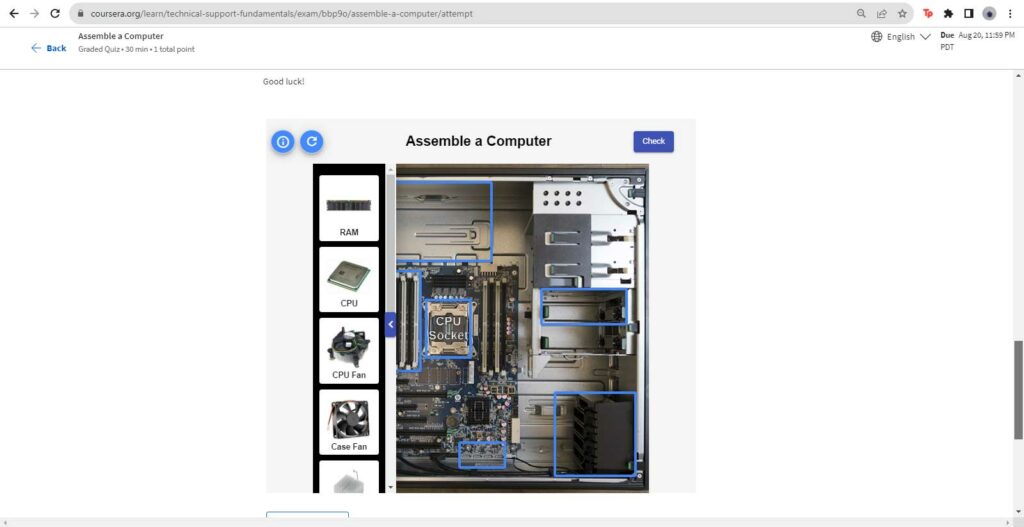
The courses also include a discussion forum where you may post questions or issues that need explanation, receive feedback, and interact with other students who have taken or are currently taking the course. The other students can also benefit from your knowledge and thoughts. The discussion forums are intended to assist you in moving forward, whether you’re having trouble understanding a concept, finishing a practice exercise, or simply want more information on a certain topic.

The IT Security course was a completely new idea for me, and I had a lot of questions and was perplexed by a lot of the topics presented in it. I found the discussion forum to be of particular help during this time. I would highly recommend going to the Discussion Forum anytime you have a problem in the assessment or generally throughout the course because most of the issues I had were already addressed there. The Resources option is also quite beneficial because it contains Frequently Asked Questions and offers useful links and resources to help you learn the material from other sources, such as intel.com.
Course 1: Introduction to IT Support
Starting with a brief history of computers, the course explains how computers work and what are the building blocks of IT. It covers the fundamentals of how computer hardware does calculations and actually teaches how to build a computer from the ground up. It makes you explore the intricacies of computer hardware, learning how various components harmonize to create a functional unit, alongside comprehending the CPU’s pivotal role and the physical pathways of binary data.

Furthermore, you’ll delve into operating systems, uncovering their components, boot processes, and installation methods while also gaining practical hands-on experience with Windows and Linux. It also considers how operating systems manage and communicate with hardware. The course then steers toward computer networking and the Internet, explaining their histories, dynamics, and impacts—both positive and negative—on the world and elucidating the mechanics of data traversal across the web.
It also covers how applications and programs link everything together and enable user interaction with these systems. Lastly, the focus shifts to computer software, encompassing software types, installation, management, and the intricacies of program-execution processes. The final module underscores the significance of troubleshooting, customer support, and effective communication in tech roles, culminating in a skill set equipped to handle real-world scenarios and translate technical knowledge into practical solutions.
(Note also that this course is included in the Bachelor of Applied Arts and Sciences program of The University of North Texas. In case you happen to be interested in this program, your courses will count towards your degree learning if you apply and are accepted.)
Course 2: The Bits and Bytes of Computer Networking
This course covers a range of topics to provide a solid understanding of computer networking. The first week introduces the TCP/IP and OSI networking models, detailing the interactions between network layers and exploring essential networking devices. The course then delves deeper into IP addressing, subnetting, encapsulation, and routing, gaining insight into how the Internet functions. It explores the transport and application layers, delving into TCP ports, headers, connection-oriented protocols, and data integrity mechanisms.

Week four focuses on networking services, explaining the significance of DNS, DHCP, NAT technologies, VPNs, and proxies in maintaining secure and efficient networks. The fifth week explains the evolution and contemporary workings of the Internet, highlighting various connectivity technologies, components of WANs, and basics of wireless and cellular networking. The final week wraps up the course by discussing the future of computer networking and providing practical guidance on troubleshooting network connectivity issues using tools available in Windows, MacOS, and Linux operating systems.
Course 3: Operating Systems and You - Becoming a Power User
This course comprehensively explores Windows and Linux operating systems (OS) over six weeks. It starts with the basics of file and directory management, covering Windows and Linux OS. It provides hands-on experience with graphical user interfaces (GUIs), command-line interfaces (CLIs), and Linux shells, enabling learners to manipulate files, directories, and text. It then focuses on configuring users and permissions, a crucial skill for IT Support Specialists. It teaches how to grant and manage user access and permissions in Windows and Linux environments.

You will also learn package and software management, exploring the intricacies of installing, updating, and removing software using Windows GUIs, CLIs, and Linux shells. It also sheds light on filesystems, covering different types, disk partitioning, virtual memory, and essential skills for IT Support Specialists.
The concluding week addresses practical aspects such as remote access, system monitoring through logs, virtualization, and OS deployment techniques. By merging theoretical knowledge with hands-on experience, the course empowers you to effectively debug issues within Windows and Linux OS.
Course 4: System Administration and IT Infrastructure
This course is a comprehensive exploration of the essential aspects of managing IT systems. It starts with introducing you to the roles and responsibilities of a System Administrator, shedding light on the distinctions between server and client machines, and establishing the groundwork for the course’s objectives.

The course then delves deeper, addressing key areas of IT infrastructure services, network and platform services, and directory services. You’ll gain insights into server operating systems, virtualization, network services, DNS, and various software and platform services. You will also develop troubleshooting techniques and practical management skills for ensuring productive and secure IT infrastructure.
The course makes you adept at handling IT infrastructure services, managing network and platform services, understanding directory services, and implementing robust backup and recovery strategies. The final project requires you to apply system administration and IT infrastructure concepts to solve real-world problems of IT companies in three scenarios.
Course 5: IT Security - Defense against the digital dark arts
The final course of the program offers an in-depth journey through various aspects of cybersecurity. It helps you progressively build a solid foundation in security practices. It establishes a fundamental understanding of security risks, vulnerabilities, threats, and common security attacks, as well as the core principles underlying security, known as the “CIA” principle. It then delves into cryptology, where you’ll explore encryption practices, algorithms, and hashing methods, enabling you to comprehend symmetric and asymmetric encryption and make appropriate cryptographic choices.

It also focuses on secure network architecture, equipping you with skills to implement network security measures, mitigate risks in wireless networks, and monitor network traffic. The final module thoroughly examines system and application hardening, offering insights into system components, host-based firewalls, anti-malware protection, disk encryption, and software patch management. The final project requires you to make a security infrastructure design document for a fictitious organization.
The concluding module brings your understanding full circle by guiding you in creating a security-conscious company culture. You’ll determine measures to align with the three goals of security, design a security plan for an organization, and craft a disaster recovery plan. Throughout the course, you’ll acquire the skills needed to secure IT environments, defend against threats, and design security-conscious systems. The Program culminates in job readiness activities, helping you refine your resume, practice interview skills, and prepare to apply your newfound expertise in the professional world.
What do others say?
Student reviews for the Google IT Support Professional Certificate on Coursera are predominantly positive. Learners praise the course for its practical projects, hands-on approach, and thorough coverage of IT concepts. Some participants mention the course’s challenging nature, especially for beginners, and suggest the need for more detailed explanations and clear demonstrations in certain modules, especially the last course on ‘IT Security: Defense against the digital dark arts’.
While there are concerns about vague questions and unclear guidelines in quizzes in later courses, this is understandable since the content covered in those courses is quite more advanced than the starting ones. Reviews on other platforms, such as Indeed, Quora, and Reddit, suggest similar thoughts, further emphasizing the Certificate’s high ratings for its comprehensive curriculum and real-world examples. While some learners stress the steep learning curve towards the last courses and their time-consuming nature, they unanimously agree that the Program’s value lies in the skills and knowledge acquired.
Conclusion and recommendations
The content covered in the Google IT Support Professional Certificate program is highly relevant to modern IT roles and system administration practices. As technology continues to shape the world, the ability to streamline processes, optimize workflows, and harness the power of automation has become an essential skill set for success. The course’s emphasis on wireless networking, troubleshooting, cloud computing, and system administration aligns with the growing importance of these skills in the IT and tech support industry.
As a beginner in the IT field, you may encounter some challenges, particularly in the courses related to IT security IT infrastructure services. However, with dedication, practice, and leveraging additional resources as needed, you can overcome these challenges and benefit greatly from the certificate program’s content.
The best thing about Coursera’s certificates is that well-known IT companies like Google, Facebook, Amazon, IBM, and others provided them, helping make them globally recognized. In the United States, 75% of graduates of the Google IT Support Professional Certificate program report a positive career outcome within six months, such as a new job, better skills, a promotion, or a pay rise. This Certificate also prepares you for the CompTIA A+ examinations, the de facto standard for IT certification
40% ($140 USD) off your first year of Coursera Plus Annual (expires 2 December 2024)
